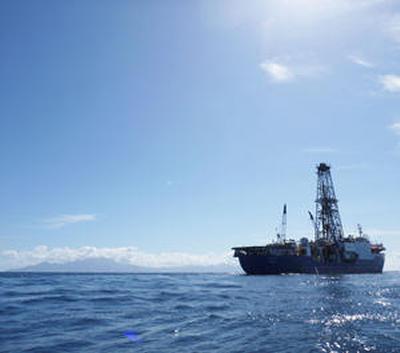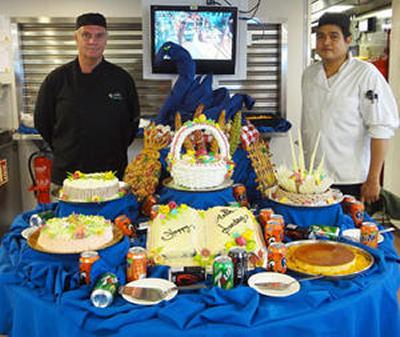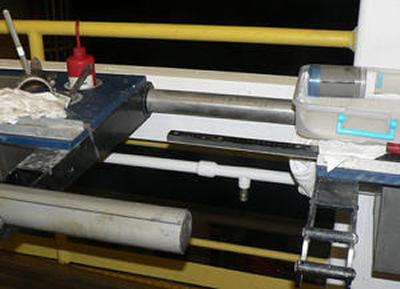Scientists based at the National Oceanography Centre, NOC, are onboard the RV JOIDES Resolution as part of the Integrated Ocean Drilling Program, IODP. Expedition 340 will look at volcanism and landslides around the Lesser Antilles.
Professor Martin Palmer, Ocean and Earth Science University of Southampton and Dr Pete Talling, NOC, will be sending a series of weekly updates from the ship.

April 16, 2012
We have just left the waters of Martinique at the start of our two day transit to our final port of Curacao - and so ends our six week sojourn in the sunny Caribbean.
We have cored over twenty holes at nine different sites off the islands of Montserrat, Dominica and Martinique. This activity has yielded nearly three kilometres of core at a recovery rate approaching seventy percent - far higher than many people were anticipating at the start of the expedition. For those of us involved in the very first planning meeting - which took place at Southampton - this has been the culmination of six years of effort.
For all the scientists on the expedition the challenge is now to ensure that we follow up this effort and expense with the highest possible quality research on the cruise materials over the coming years. Alongside the scientists, from eight different nations, the technical staff from IODP, the drillers on the floor and the officers and crew of the JOIDES Resolution all contributed greatly to the success of the expedition - our thanks go to them all.
The winds subsided sufficiently on the last few day of the cruise for some of us to be able to take the RIB out for a trip round the ship. So, I leave you with a shot of the JR basking in the sun, with Martinique in the background.

April 11, 2012
We are now approaching the last week of the expedition and this time next week we will (hopefully!) be relaxing in the hotel bar in Curacao.
In the meantime, we are coring large mass flow deposits off the coast of Martinique. These are difficult sites to get material from as they tend to be made up of layers of coarse sand, lying between muddier hemipelagic sediments. As a result, there have been a few sites where core recovery has not been as good as we might have wished for. This wasn't helped when we became entangled in an unmarked fish attraction device (FAD) that managed to wrap close to 3 km of line around the drill pipe. However, at this present site we have managed to piston core (APC) all the way to a depth of about 200 metres below the seafloor, with close to 100% recovery. At that point the sediment became too stiff and we had to switch over to the extended core barrel (XCB), but recovery is still pretty high.
The material we are bringing up is part of a massive debris flow that appears to have originated from a flank collapse on the island, which lies about 20 km to our east. The sedimentary layers are constantly switching between close to flat-lying and dips of up to 60 degrees - suggesting that there has been some major deformation during the flow.
We missed the traditional Easter bank holiday celebrations in the UK, and had to make do with sitting in the 30 degree sunshine after digesting some of the spectacular cakes provided by the catering staff.

April 02, 2012
There are a total of about 120 people on board the Joides Resolution, with scientists making up about a quarter of the crew. The scientific party is divided into two shifts - one half from midnight to midday, and the other covering the day shift - that are essentially mirror images of each other.
Given the nature of the sediments we are attempting to recover, the largest and by far the busiest group are those devoted to describing the cores. This group includes Pete Talling from the NOC. Given that a single 10 metre core may contain upwards of 50 ash layers or turbidites, and there are times when cores are arriving on deck every 45 minutes, the work pressure can be intense. Another group of scientists is devoted to measuring physical properties of the sediment cores, such as magnetic susceptibility and density, as well as simply providing a photographic record of all the material.
Fortunately, my job is a little more measured in terms of the spread of the work load. Along with three other geochemists, it is my responsibility to select 10 cm sub-sections of the core from which we extract the pore fluids by squeezing the sediments in a high pressure cylinder. The picture shows the end of the core with the capped whole round section of sediment in the top right hand corner ready for transport to the lab. We then measure the chemical composition of these pore fluids to determine the diagenetic reactions taking place within the sediment column.
All these results will appear in the Site Reports of the expedition that will be available to the wider scientific community with a few months of the end of the cruise, and will help other scientists who weren't on the ship select samples for analysis in the coming years.